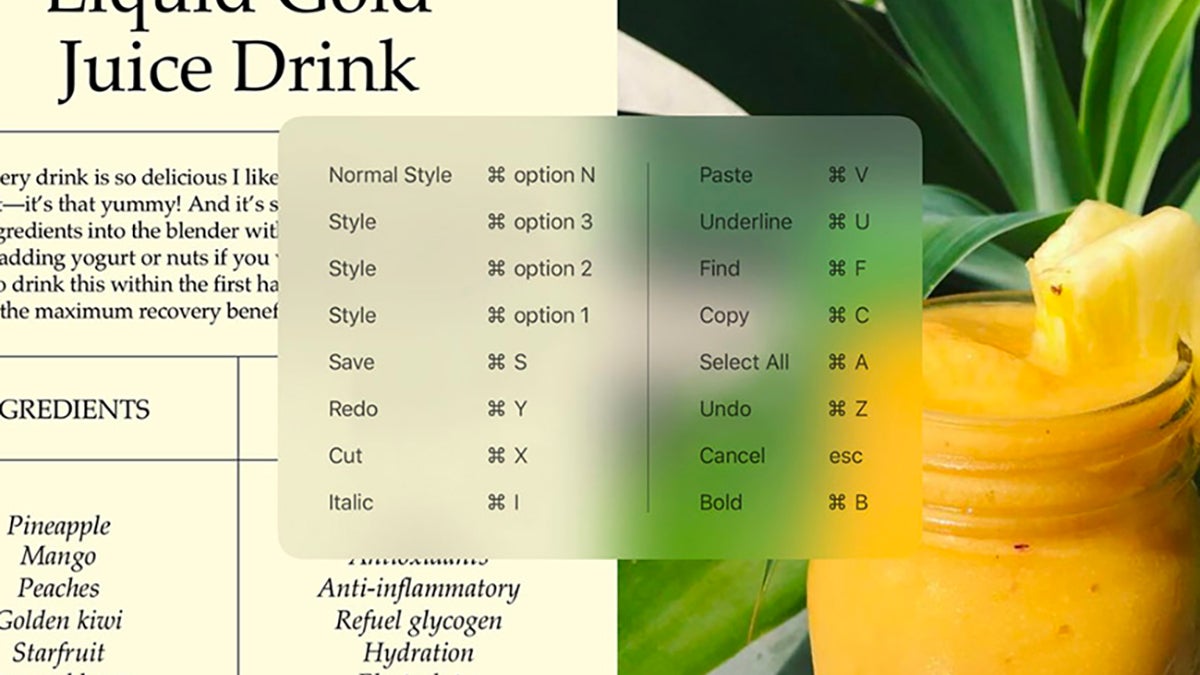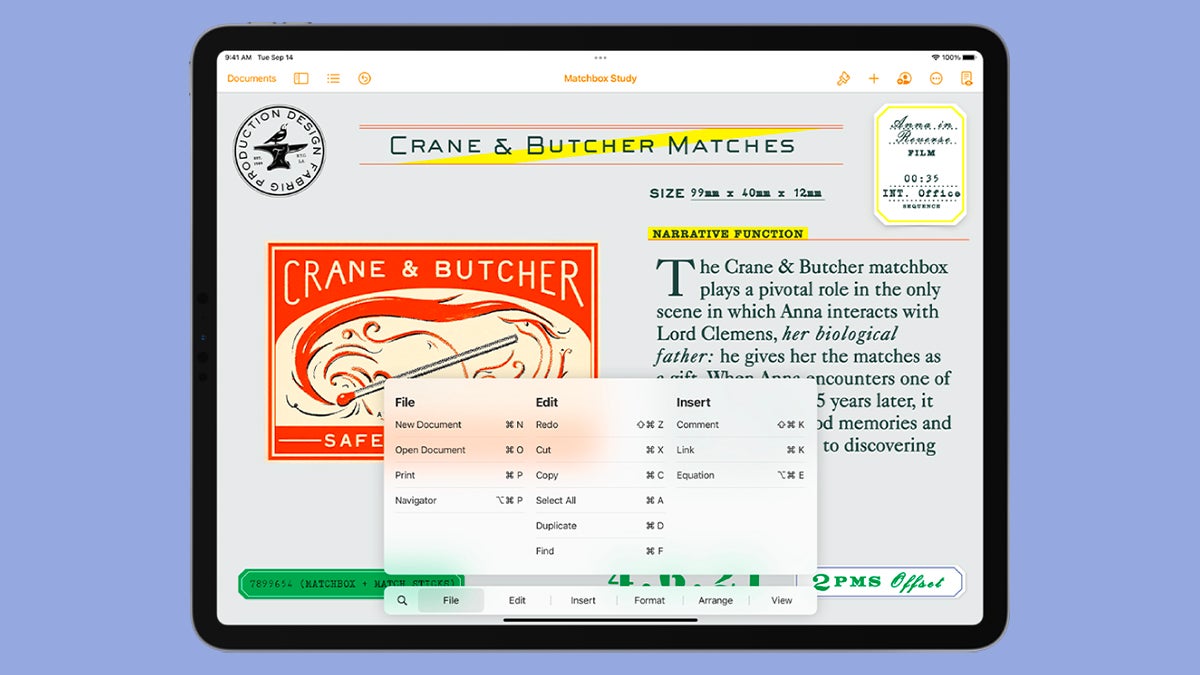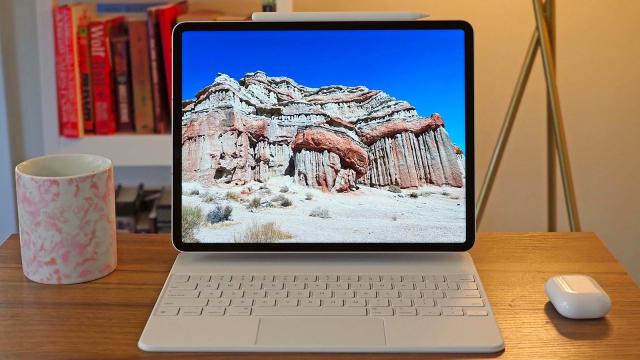The iPad is a capable laptop replacement in many ways, and iPadOS multitasking features and Apple’s Magic Keyboard take that to the next level. iPadOS differs from iOS in several ways, and includes keyboard shortcuts and trackpad gestures that unlock functionality you can’t get on an iPhone.
First thing’s first: To get started with iPad keyboard shortcuts and gestures, you’ll need to set up a keyboard and trackpad with your iPad — either the official Magic Keyboard or a third-party option. If you want to see the available keyboard shortcuts for the app you’re currently using, press and hold the Command button and choose between the different categories that show up on screen.
Some of the common ones you might see are Cmd+C to copy, Cmd+V to paste, and Cmd+Z to undo the most recent action, for example. These match the same shortcuts on macOS on the desktop, and certainly make it easier to handle text editing — you can use Command+I for italics, Command+B for bold, and Command+U for underlined text too, which you’re probably familiar with in word processing apps.
In several apps, you can use Command+N to create a new file, Command+O to open an existing file, and Command+P to print the current file. Others are more specific, such as Command+R to reply to messages and Command+Shift+F to forward emails in the default Mail app that Apple develops. In Apple Calendar, hold down Command and tap a number from 1–4 to switch between the different views.

You’ll need to investigate your favourite apps to see if there are any keyboard shortcuts available (for example, Things has more than most), but in some specific apps these shortcuts will need to be turned on. With Gmail for the iPad, you need to pick Settings from the app menu, then tap Enable keyboard shortcuts. Hold down the Command key and you can then take advantage of the same shortcuts used by Gmail on the web — C to compose, E to archive, R to reply, and so on.
If you spend a lot of time in Safari on your iPad, you can use a lot of the same keyboard shortcuts as you do on macOS: Command+T to open a new tab, Command+W to close a tab, Control+Tab (or Control+Shift+Tab to cycle through open tabs, and so on. Then there are the system-wide shortcuts that don’t depend on an individual app and are going to work anywhere:
- Command+H: Go back to the iPadOS home screen
- Command+Space: Show the search box (or hide it if it’s already visible)
- Command+Tab: Switch to the most recently used app
- Command+Shift+3: Take a screenshot (which is sent to the Photos gallery)
- Command+Shift+4: Take a screenshot and open Markup to view or edit it
- Command+Option+D: Show or hide the iPadOS Dock
- Command+Tab: Bring the apps switcher interface up on screen
- Command+Right or Left Arrow: Quickly switch between open apps
- Command+. (period): The equivalent of the Esc key
- Tab: Navigate between fields or lists
- Globe+S: Open Siri ready for a voice command
- Shift+Globe+A: Show the App library on your iPad
- Control+Globe+Right or Left Arrow: Snap a window to the right or left of the display
- Globe+ (backslash): Bring up the Slide Over interface
- Globe+Right or Left arrow: Move the Slide Over panel
- Globe+F: Go into fullscreen mode
- Globe+C: Open the Control Centre
You can create your own custom keyboard shortcuts, too. To do this, choose Accessibility from Settings, then Keyboards, then turn on Full Keyboard Access. Choose Commands, then select the command you want to assign a shortcut to, and then pick your custom key combination. Tap Done to confirm.

There’s also the option to change the modifier keys (like Command or Globe) that iPadOS recognises as launching shortcuts. From Settings on your iPad, you need to choose General, Keyboard, Hardware Keyboard and then Modifier Keys to make changes — this can be handy if you’re using a third-party keyboard that doesn’t have some of the same keys as the one Apple makes.
If you’re using a Magic Keyboard (rather than a Smart Folio keyboard), then you can take advantage of trackpad gestures just like with a MacBook.
-
Two finger swipe down: Open Spotlight search/scroll in Safari
-
Two finger tap: Bring up the context-sensitive quick actions menu
-
Three finger swipe down: Go back to the home screen
-
Three finger swipe up: See open apps in the multitasking view
-
Three finger swipe left or right: Jump between open apps
While the iPad doesn’t support quite as many shortcuts as Apple’s desktops and laptops do, even just using a few of the keyboard combinations that we’ve mentioned here can make a big difference in how you use your iPad — and make it more of a true MacBook replacement.
